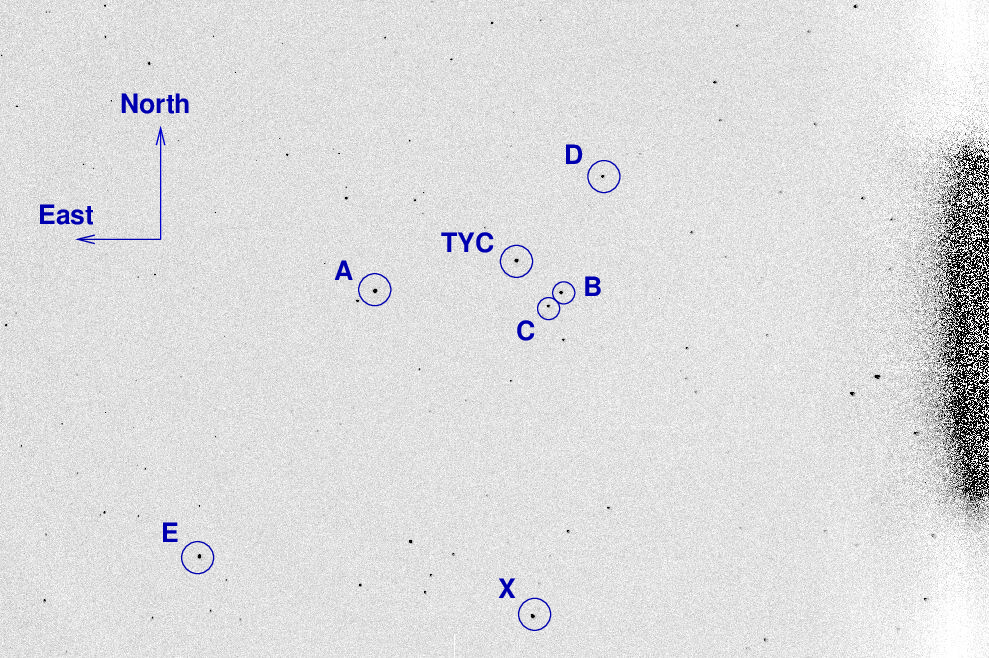
On the night of May 06/07, 2020, under good conditions, I acquired two sets of observations. First, measurements of the eclipsing binary system TYC 2483-160-1 to support a study of possible exoplanets around it; after that, another set of images of Wolf 359, as part of the the New Horizons parallax project.
I noticed an AAVSO Alert which appeared on May 06, 2020, requesting observations of the system TYC 2483-160-1 on the very same night -- just a few hours away.
Exoplanet researchers Dr. Veselin Kostov and his collaborators at NASA Goddard, and Prof. Bill Welsh and Dr. Jerome Orosz at San Diego State University, have issued a request for immediate help in observing the primary eclipse of a new candidate TESS circumbinary system – namely one where an exoplanet is orbiting an eclipsing binary.
Fortunately, the weather was good, so I decided to give it a try.
The main setup was:
Notes from the night:
I started using the guider, with a 5-second guide exposure time, and it was tracking very well. As usual, I moved from dome to house and started a Remote Desktop session so that I could monitor the data acquisition. After 29 images, the MaximDL procedure hung up and froze. I had to go outside, kill it via the Task Manager, and start up again. Just as I started the guide camera this second time, MaximDL froze again. So, after killing it a second time, I decided not to use the guider at all. For the rest of the run (about 3 hours), I was able to watch things via Remote Desktop with no problems.
The object is at position
RA = 08:34:38.8 Dec = +31:33:15 (J2000)
A chart of the field is shown below. The size of the chart is about 41 x 27 arcminutes. The noisy area at right (West) is the shadow of the guider's pickoff mirror.

I've marked the location of several comparison stars, which also appear in light curves below. In particular,
star UCAC4 B V r ----------------------------------------------------------- A UCAC4 608-044531 10.231 9.715 9.624 B UCAC4 608-044511 12.241 11.724 11.607 E UCAC4 607-042934 10.889 10.315 10.194 X UCAC4 607-042891 aka YY Cnc -----------------------------------------------------------
I ran the camera at -20 C. Nothing out of the ordinary.

The sky value shows no strong evidence for clouds. The break in values early was caused by the MaximDL problems mentioned earlier.

Here's a record of the telescope's drift. The big jump occurs when MaximDL froze, and I had to move the telescope slightly to recenter the star.
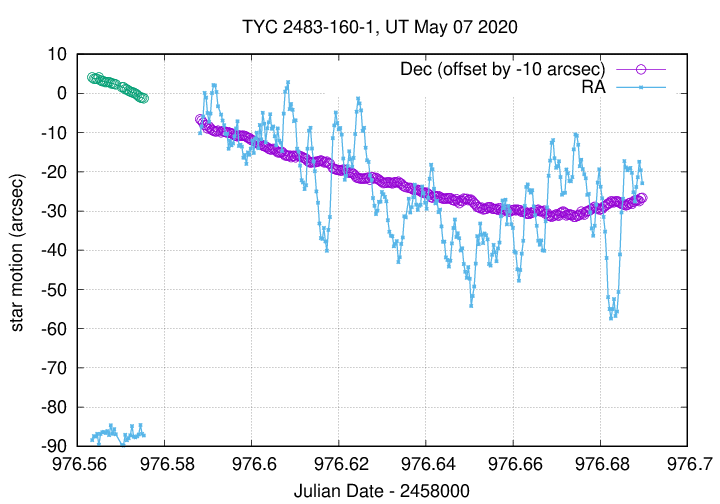
The number of objects detected.
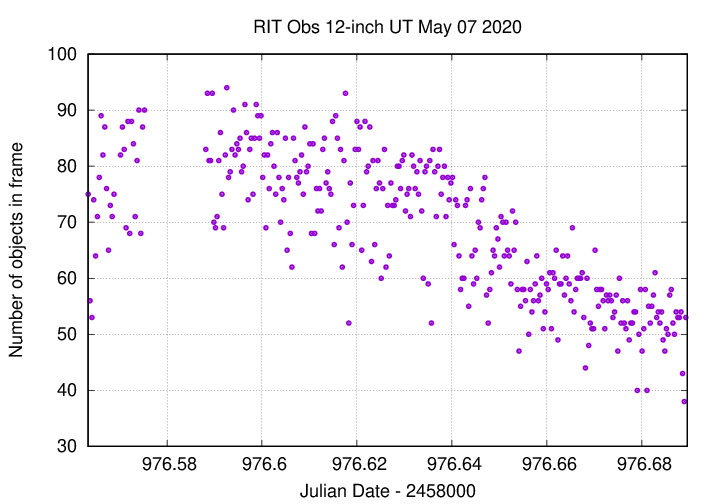
I used an aperture with radius 4.0 pixels tonight.

Below is the ensemble zeropoint as a function of time; I removed two outlying images. Note the sharp rise with airmass near the end of the run.
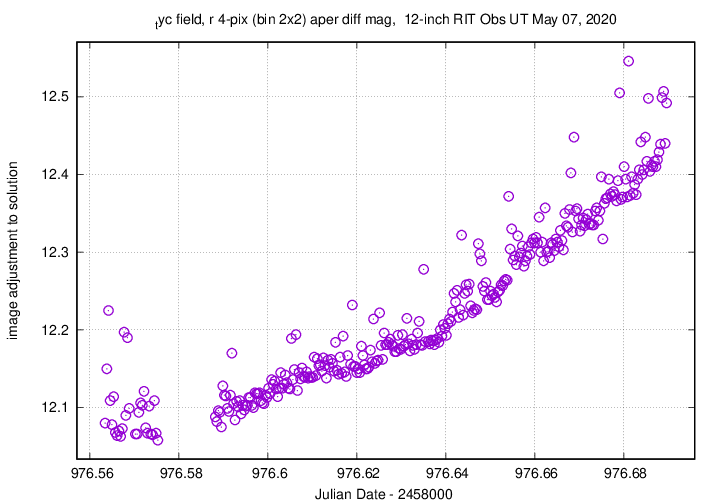
Using aperture photometry with a radius of 4 pixels (binned 2x2, each pixel is 1.24 arcsec, so a radius of 5.0 arcsec), I measured the instrumental magnitudes of a number of reference stars and the target. Following the procedures outlined by Kent Honeycutt's article on inhomogeneous ensemble photometry, I used all stars available in each image to define a reference frame, and measured each star against this frame.
Sigma-vs-mag plots show that the floor was about 0.010 mag overall.
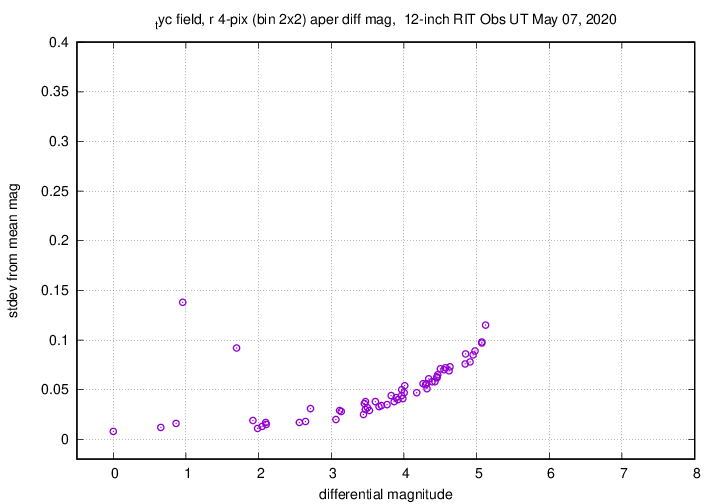
Here are light curves of the variable and the field stars. We caught most of the eclipse of the target, though we missed both ingress and egress. The star marked "X" is undergoing an eclipse of its own: it is the eclipsing binary system YY Cnc.
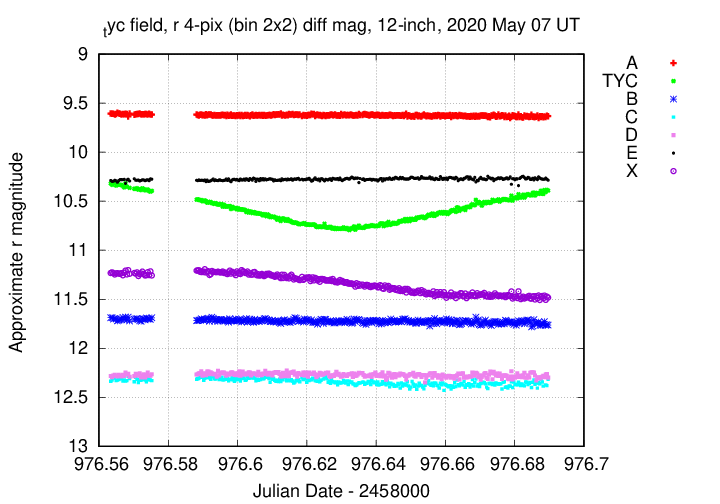
I used the AAVSO value for the r-band magnitude of star "A" to shift the ensemble magnitudes to the standard r-band scale (even though I used an "R" filter).
Here's a closeup of the target and a few comparison stars; note the gradual trends which might be due to second-order extinction, or to the position of the stars in the focal plane.
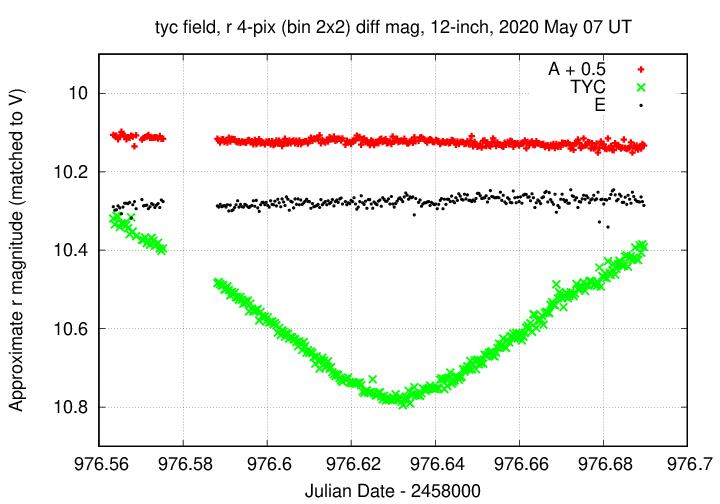
I've computed the magnitude of the target based on the ensemble photometry. The first few lines of an ASCII datafile are shown below; you can download the entire file from the link after it. I've submitted my measurements to the AAVSO.
# Measurements of TYC-2483-160-1 made at RIT Obs, UT 2020 May 7, # in good conditions but high airmass, # by Michael Richmond, # using Meade 12-inch LX200 and ATIK 11000. # Exposures 20 seconds long, r filter. # Tabulated times are midexposure (FITS header time - half exposure length) # and accurate only to +/- 1 second (??). # 'mag' is a differential magnitude based on ensemble photometry # using a circular aperture of radius 4 pix = 5.0 arcseconds. # which has been shifted so UCAC4 608-044531 has mag=9.624 # which is its r-band magnitude according to UCAC4. # # UT_day JD HJD mag uncert May07.08816 2458976.58816 2458976.58681 10.484 0.017 May07.08850 2458976.58850 2458976.58715 10.481 0.016 May07.08884 2458976.58884 2458976.58749 10.486 0.017
As described in the New Horizons Parallax Program,
On April 22 and 23, New Horizons will take images of two of the very nearest stars, Proxima Centauri and Wolf 359. When combined with Earth-based images made on the same dates, the result will be a record-setting parallax measurement yielding 3D images of these stars popping out of their background star fields that the New Horizons project will share with the public.
I have taken image of this field earlier:
I decided to take another set of images, in order to check my measurement routines. By this time, about 20 days after the most recent measurement, the star ought to have moved significantly due to its high proper motion (about -3800 mas/yr in RA and -2700 mas/yr in Dec).
I took a photo of the finder TV's screen when pointing to Wolf 359; this could be a useful reference for the future:
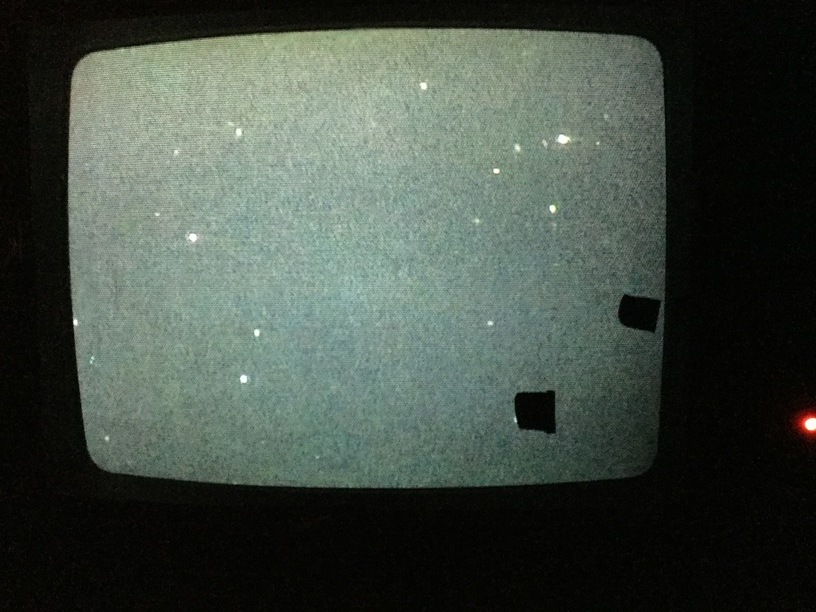
The object WAS located at this position in 2000,
RA = 10:56:28.8 Dec = +07:00:52 (J2000)
but since it has such high proper motion (about 4.5 arcsec per year), it is now closer to RA = 10:56:23.6 and Dec = +06:59:58.3
A chart of the field is shown below. The size of the chart is about 41 x 27 arcminutes. The noisy area at right (West) is the shadow of the guider's pickoff mirror.
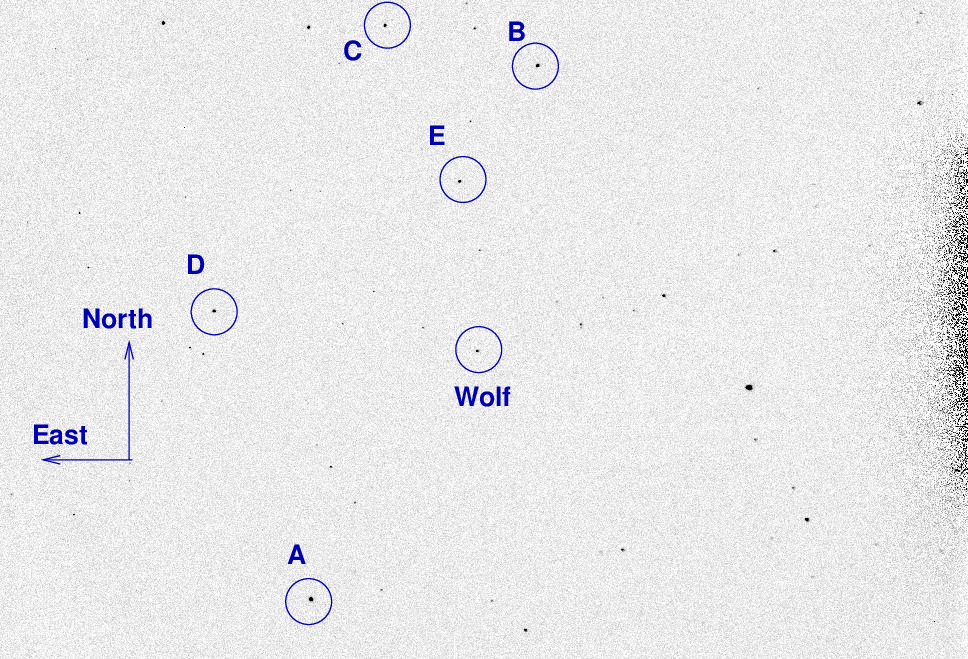
I've marked the location of several comparison stars, which also appear in light curves below. In particular,
star UCAC4 B V r ----------------------------------------------------------- A 485-052029 10.530 10.157 10.122 -----------------------------------------------------------
I took a series of 40 exposures of the field, using the R-band filter and an exposure time of 20 seconds. The field was at pretty high airmass, so these measurements may be of lower-than-ordinary quality.
Using the same techniques as described for earlier nights, I matched detected stellar positions to the Gaia DR2 catalog; this time, I used a linear model and included all stars in the catalog. The resulting positions show a mildly significant change compared to those of April (significant at the one-to-two sigma level). The differences in position correspond nearly exactly to the known proper motion.
Rah.
In order to detect the parallax of the target, I would need to continue to monitor the field frequently, so that I could measure the mean proper motion and remove it. In theory, the parallax should detectable in the residuals ...
Last modified 5/07/2020 by MWR.